Modalities and Trends of Variability of Plankton Concentrations Recorded During a Digital Holographic Experiment In Situ
Abstract
1. Introduction
2. Methods and Tools
2.1. Model Description
- —speed of the research vessel (if the vessel is in place and the net is lifted vertically, then this will be the speed of the net movement),
- —time passed by the research vessel (net) for path ,
- —plankton concentration at a point with coordinate at time ,
- —changes in plankton concentration due to turbulence (t) during net transportation—assessment of spatial variability,
- —natural changes in the concentration of plankton as a result of migrations (m) during net transportation—assessment of temporal variability.
- —DHC entrance pupil area,
- —DHC working volume length,
- —equivalent length of the path “traveled” by the DHC working volume during time of M measurements,
- —average current velocity,
- —current time for path ,
- —concentration of plankton at the point of the DHC location with the coordinate at the moment of time ,
- —changes in the concentration of plankton under the influence of turbulence (t) caused by the current passing through/around the DHC—assessment of spatial variability,
- —natural changes in the concentration of plankton as a result of migrations (m) during measurements using the DHC—assessment of temporal variability.
- and are large enough to consider and as limit concentrations, which the respective sums tend to when the sampling size increases. This happens when the fluctuating component tends to 0, i.e., Ratios (4), (6) are satisfied;
- directions of vectors and may not coincide in the case of the stable biocenosis of the fractal structure spot and measurements inside it;
- averaging times and must be large enough for the fluctuation part to be equal to 0. Note that for this is set by selecting the parameter ;
- sampling shall be performed in one layer (tier).
2.2. Marine Experiment and Data Processing Methods
- band of diurnal (microscale) rhythms, whose time scale of changes is measured in hours, frequency range—1/10 h−1–1/3 h−1;
- band of diurnal (mesoscale) rhythms, whose time scale of changes is measured in tens of hours, frequency range—1/50 h−1–1/10 h−1;
- band of synoptic rhythms, whose scale of changes is measured in months, seasons, frequency range—less than 1/50 h−1;
- area of seasonal rhythms, whose scale of changes is measured by seasons, years, frequency range—less than 1/50 h−1.
- Small-scale inhomogeneities. Spatial dimensions range from tens of centimeters to meters within a spot of the fractal structure. They are caused by small-scale turbulence, movements of crustaceans, and biotic processes of diurnal duration typical for different taxa of the population.
- Mesoscale inhomogeneities. Spatial dimensions range from hundreds of meters to kilometers. They are determined by the characteristic size of the fractal structure spot. Inhomogeneities of this type are generated by biotic interactions of diurnal duration initiated by the illumination factor. They are adjusted by inertial and tidal movements in the ocean and diurnal fluctuations in the intensity of the thermodynamic interaction of the ocean and atmosphere. Behavioral responses and plankton biocenosis strategies can be observed at the mesoscale.
- Synoptic inhomogeneities. Spatial dimensions of the drivers are the characteristic scale of the variability of hydrophysical fields in the ocean, which ranges from tens to hundreds of kilometers. The time scale of their existence ranges from several days to months. Such inhomogeneities in the distribution of temperature and salinity are associated with the existence of vortex formations in the ocean. Plankton fields still occupy hundreds of meters and kilometers, but the morphometric characteristics of the population and spatial localization in the form of a fractal structure with elements of synchronization of plankton properties inside the spots change under the influence of hydrophysical fields.
- Large-scale inhomogeneities. The estimates of horizontal dimensions for the inhomogeneities of this scale range from hundreds to thousands of kilometers. The elements of the large-scale structure of hydrophysical fields are characterized by different scales of temporal variability—seasonal, interannual, and intercentury. Under the influence of these drivers, not only does the fractal structure change but also the taxonomic composition of plankton biocenoses [21,22].
- S—structuring rhythms associated with turbulence (~25–300 h);
- C—circadian rhythm (~23–25 h), solar synchronization;
- DV—diurnal variability rhythm (~12 h), basic nutrition;
- T—tidal rhythm (10.5–13 h), tidal synchronization of the DV rhythm;
- U—first ultradian rhythm caused by fractional nutrition.
3. Results and Discussion
3.1. Synoptic Band Modalities in Plankton Concentrations
3.2. Mesoscale Band Modalities in Plankton Concentrations
3.3. Correlation of Temporal Modalities with Spatial Scales for Bioindication Purposes
4. Conclusions
- to clarify spatial and temporal scales of the studied phenomena;
- to determine the effective range of estimates and understand the sampling volumes required for clear informative results within a particular modality;
- to reasonably plan the measurement experiment and interpret the data obtained using different-scale measuring tools;
- to study the processes of pollution propagation.
Author Contributions
Funding
Data Availability Statement
Conflicts of Interest
Abbreviations
| DHC | Digital Holographic Camera |
| CMOS | Complementary Metal–Oxide–Semiconductor |
| MMBI RAS | Murmansk Marine Biological Institute of the Russian Academy of Sciences |
| FOCL | Fiber-Optic Communication Line |
References
- Steele, J.H. (Ed.) Spatial Pattern in Plankton Communities; Springer: Boston, MA, USA, 1978; ISBN 978-1-4899-2197-0. [Google Scholar]
- Robinson, K.L.; Sponaugle, S.; Luo, J.Y.; Gleiber, M.R.; Cowen, R.K. Big or Small, Patchy All: Resolution of Marine Plankton Patch Structure at Micro- to Submesoscales for 36 Taxa. Sci. Adv. 2021, 7, eabk2904. [Google Scholar] [CrossRef]
- Mojica, K.D.A.; van de Poll, W.H.; Kehoe, M.; Huisman, J.; Timmermans, K.R.; Buma, A.G.J.; van der Woerd, H.J.; Hahn-Woernle, L.; Dijkstra, H.A.; Brussaard, C.P.D. Phytoplankton Community Structure in Relation to Vertical Stratification along a North-South Gradient in the Northeast Atlantic Ocean. Limnol. Oceanogr. 2015, 60, 1498–1521. [Google Scholar] [CrossRef]
- Marguerit, C.; Schertzer, D.; Schmitt, F.; Lovejoy, S. Copepod Diffusion within Multifractal Phytoplankton Fields. J. Mar. Syst. 1998, 16, 69–83. [Google Scholar] [CrossRef]
- Balvert, S.F.; Duggan, I.C.; Hogg, I.D. Zooplankton Seasonal Dynamics in a Recently Filled Mine Pit Lake: The Effect of Non-Indigenous Daphnia Establishment. Aquat. Ecol. 2009, 43, 403–413. [Google Scholar] [CrossRef]
- Dalpadado, P.; Arrigo, K.R.; van Dijken, G.L.; Skjoldal, H.R.; Bagøien, E.; Dolgov, A.V.; Prokopchuk, I.P.; Sperfeld, E. Climate Effects on Temporal and Spatial Dynamics of Phytoplankton and Zooplankton in the Barents Sea. Prog. Oceanogr. 2020, 185, 102320. [Google Scholar] [CrossRef]
- Longobardi, L.; Dubroca, L.; Margiotta, F.; Sarno, D.; Zingone, A. Photoperiod-Driven Rhythms Reveal Multi-Decadal Stability of Phytoplankton Communities in a Highly Fluctuating Coastal Environment. Sci. Rep. 2022, 12, 3908. [Google Scholar] [CrossRef] [PubMed]
- Bandara, K.; Varpe, Ø.; Wijewardene, L.; Tverberg, V.; Eiane, K. Two Hundred Years of Zooplankton Vertical Migration Research. Biol. Rev. 2021, 96, 1547–1589. [Google Scholar] [CrossRef]
- Kvile, K.; Prokopchuk, I.P.; Stige, L.C. Environmental Effects on Calanus Finmarchicus Abundance and Depth Distribution in the Barents Sea. ICES J. Mar. Sci. 2022, 79, 815–828. [Google Scholar] [CrossRef]
- Häfker, N.S.; Connan-McGinty, S.; Hobbs, L.; McKee, D.; Cohen, J.H.; Last, K.S. Animal Behavior Is Central in Shaping the Realized Diel Light Niche. Commun. Biol. 2022, 5, 562. [Google Scholar] [CrossRef]
- Bandara, K.; Varpe, Ø.; Maps, F.; Ji, R.; Eiane, K.; Tverberg, V. Timing of Calanus Finmarchicus Diapause in Stochastic Environments. Ecol. Modell. 2021, 460, 109739. [Google Scholar] [CrossRef]
- Varpe, Ø.; Jørgensen, C.; Tarling, G.A.; Fiksen, Ø. The Adaptive Value of Energy Storage and Capital Breeding in Seasonal Environments. Oikos 2009, 118, 363–370. [Google Scholar] [CrossRef]
- Varpe, Ø.; Jørgensen, C.; Tarling, G.A.; Fiksen, Ø. Early Is Better: Seasonal Egg Fitness and Timing of Reproduction in a Zooplankton Life-History Model. Oikos 2007, 116, 1331–1342. [Google Scholar] [CrossRef]
- Grigor, J.J.; Søreide, J.E.; Varpe, Ø. Seasonal Ecology and Life-History Strategy of the High-Latitude Predatory Zooplankter Parasagitta Elegans. Mar. Ecol. Prog. Ser. 2014, 499, 77–88. [Google Scholar] [CrossRef]
- Espinasse, B.; Tverberg, V.; Kristensen, J.A.; Skreslet, S.; Eiane, K. Winter Mortality in Calanus Populations in Two Northern Norwegian Fjords from 1984 to 2016. Polar Biol. 2018, 41, 1405–1415. [Google Scholar] [CrossRef]
- Hobbs, L.; Banas, N.S.; Cohen, J.H.; Cottier, F.R.; Berge, J.; Varpe, Ø. A Marine Zooplankton Community Vertically Structured by Light across Diel to Interannual Timescales. Biol. Lett. 2021, 17, 20200810. [Google Scholar] [CrossRef]
- Tzella, A.; Haynes, P.H. Small-scale spatial structure in plankton distributions. Biogeosciences 2007, 4, 173–179. [Google Scholar] [CrossRef]
- Levy, M.; Martin, A.P. The influence of mesoscale and submesoscale heterogeneity on ocean biogeochemical reactions. Glob. Biogeochem. Cycles 2013, 27, 1139–1150. [Google Scholar] [CrossRef]
- Muñiz, O.; Rodríguez, J.G.; Revilla, M.; Laza-Martínez, A.; Seoane, S.; Franco, J. Inhomogeneity detection in phytoplankton time series using multivariate analyses. Oceanologia 2020, 62, 243–254. [Google Scholar] [CrossRef]
- Zhang, Z.; Li, H.; Shen, W.; Du, X.; Li, S.; Wei, Z.; Zhang, Z.; Feng, K.; Deng, Y. The large-scale spatial patterns of ecological networks between phytoplankton and zooplankton in coastal marine ecosystems. Sci. Total Environ. 2022, 827, 154285. [Google Scholar] [CrossRef] [PubMed]
- Monin, A.S. Turbulence and Microstructure in the Ocean. Uspekhi Fiz. Nauk. 1973, 109, 333. [Google Scholar] [CrossRef]
- Kamenkovich, V.M.; Koshlyakov, M.N.; Monin, A.S. (Eds.) Synoptic Eddies in the Ocean; Springer: Dordrecht, The Netherlands, 1986; ISBN 978-94-010-8506-9. [Google Scholar]
- Azovsky, A.; Chertoprud, E.; Garlitska, L. Community-Level Spatiotemporal Synchrony: New Metric and Application to White Sea Meiobenthic Harpacticoids. Mar. Ecol. Prog. Ser. 2022, 698, 55–68. [Google Scholar] [CrossRef]
- Steele, J.H.; Henderson, E.W. The Role of Predation in Plankton Models. J. Plankton Res. 1992, 14, 157–172. [Google Scholar] [CrossRef]
- Scheffer, M. Should We Expect Strange Attractors behind Plankton Dynamics—And If so, Should We Bother? J. Plankton Res. 1991, 13, 1291–1305. [Google Scholar] [CrossRef]
- Medvinskii, A.B.; Petrovskii, S.V.; Tikhonova, I.A.; Tikhonov, D.A.; Li, B.-L.; Venturino, E.; Malchow, H.; Ivanitskii, G.R. Spatio-Temporal Pattern Formation, Fractals, and Chaos in Conceptual Ecological Models as Applied to Coupled Plankton-Fish Dynamics. Phys.-Uspekhi 2002, 45, 27–57. [Google Scholar] [CrossRef]
- Mimura, M.; Murray, J.D. On a Diffusive Prey-Predator Model Which Exhibits Patchiness. J. Theor. Biol. 1978, 75, 249–262. [Google Scholar] [CrossRef]
- Koenig, W.D. Global Patterns of Environmental Synchrony and the Moran Effect. Ecography 2002, 25, 283–288. [Google Scholar] [CrossRef]
- Haury, L.R.; McGowan, J.A.; Wiebe, P.H. Patterns and Processes in the Time-Space Scales of Plankton Distributions. In Spatial Pattern in Plankton Communities; Springer: Boston, MA, USA, 1978; pp. 277–327. [Google Scholar]
- Leibold, M.A.; Holyoak, M.; Mouquet, N.; Amarasekare, P.; Chase, J.M.; Hoopes, M.F.; Holt, R.D.; Shurin, J.B.; Law, R.; Tilman, D.; et al. The Metacommunity Concept: A Framework for Multi-scale Community Ecology. Ecol. Lett. 2004, 7, 601–613. [Google Scholar] [CrossRef]
- Briseño-Avena, C.; Prairie, J.C.; Franks, P.J.S.; Jaffe, J.S. Comparing Vertical Distributions of Chl-a Fluorescence, Marine Snow, and Taxon-Specific Zooplankton in Relation to Density Using High-Resolution Optical Measurements. Front. Mar. Sci. 2020, 7, 602. [Google Scholar] [CrossRef]
- Prairie, J.C.; Sutherland, K.R.; Nickols, K.J.; Kaltenberg, A.M. Biophysical Interactions in the Plankton: A Cross-scale Review. Limnol. Oceanogr. Fluids Environ. 2012, 2, 121–145. [Google Scholar] [CrossRef]
- Jumars, P.A.; Trowbridge, J.H.; Boss, E.; Karp-Boss, L. Turbulence-Plankton Interactions: A New Cartoon. Mar. Ecol. 2009, 30, 133–150. [Google Scholar] [CrossRef]
- Shim, H.; Lee, C. Effect of Gravity-Induced Fluid Inertia on the Accumulation and Dispersion of Motile Plankton Settling Weakly in Turbulence. Phys. Fluids 2022, 34, 085107. [Google Scholar] [CrossRef]
- Fuchs, H.L.; Gerbi, G.P. Seascape-Level Variation in Turbulence- and Wave-Generated Hydrodynamic Signals Experienced by Plankton. Prog. Oceanogr. 2016, 141, 109–129. [Google Scholar] [CrossRef]
- Peters, F.; Redondo, J.M. Turbulence Generation and Measurement: Application to Studies on Plankton. Sci. Mar. 1997, 61, 205–228. [Google Scholar]
- Peters, F.; Marrase, C. Effects of Turbulence on Plankton: An Overview of Experimental Evidence and Some Theoretical Considerations. Mar. Ecol. Prog. Ser. 2000, 205, 291–306. [Google Scholar] [CrossRef]
- Ross, T. A Video-Plankton and Microstructure Profiler for the Exploration of in Situ Connections between Zooplankton and Turbulence. Deep. Res. Part I Oceanogr. Res. Pap. 2014, 89, 1–10. [Google Scholar] [CrossRef]
- Franks, P.J.S.; Inman, B.G.; MacKinnon, J.A.; Alford, M.H.; Waterhouse, A.F. Oceanic Turbulence from a Planktonic Perspective. Limnol. Oceanogr. 2022, 67, 348–363. [Google Scholar] [CrossRef]
- Sprules, W.G.; Cyr, H.; Menza, C.W. Multiscale Effects of Wind-Induced Hydrodynamics on Lake Plankton Distribution. Limnol. Oceanogr. 2022, 67, 1631–1646. [Google Scholar] [CrossRef]
- Flierl, G.; McGillicuddy, D.J. Mesoscale and Submesoscale Physical—Biological Interactions. In The Sea; Robinson, A.R., McCarthy, J.J., Rothschild, B.J., Eds.; John Wiley & Sons, Inc.: New York, NY, USA, 2002; Volume 12, pp. 113–186. ISBN 0471189014. [Google Scholar]
- Shadrin, N.V.; Anufriieva, E.V. An ecosystem role of spatial and temporal inhomogeneity in feeding of plankton crustaceans. Ekosystemy 2018, 14, 119–128. [Google Scholar]
- Esau, I.N. Xxi-St Century: A Shift of Paradigm in the Planetary Boundary Layer Theory. Fundam. Appl. Hydrophys. 2022, 15, 9–18. [Google Scholar] [CrossRef]
- Ozmidov, R.V. Diffusion of Contaminants in the Ocean; Springer: Dordrecht, The Netherlands, 1990; ISBN 978-0-7923-0611-5. [Google Scholar]
- Dyomin, V.V.; Davydova, A.Y.; Morgalev, S.Y.; Kirillov, N.S.; Olshukov, A.; Polovtsev, I.; Davydov, S. Monitoring of Plankton Spatial and Temporal Characteristics With the Use of a Submersible Digital Holographic Camera. Front. Mar. Sci. 2020, 7, 653. [Google Scholar] [CrossRef]
- Dyomin, V.; Davydova, A.; Kirillov, N.; Morgalev, S.; Naumova, E.; Olshukov, A.; Polovtsev, I. In Situ Measurements of Plankton Biorhythms Using Submersible Holographic Camera. Sensors 2022, 22, 6674. [Google Scholar] [CrossRef] [PubMed]
- Dyomin, V.; Davydova, A.; Kirillov, N.; Kondratova, O.; Morgalev, Y.; Morgalev, S.; Morgaleva, T.; Polovtsev, I. Monitoring Bioindication of Plankton through the Analysis of the Fourier Spectra of the Underwater Digital Holographic Sensor Data. Sensors 2024, 24, 2370. [Google Scholar] [CrossRef] [PubMed]
- Dyomin, V.; Polovtsev, I.; Davydova, A.; Kirillov, N. Spectroscopic Aspects of Underwater Digital Holography of Plankton. Sci. Rep. 2025, 15, 1884. [Google Scholar] [CrossRef] [PubMed]
- Xie, T.; Huang, L.; Guo, Y.; Ou, Y. Modeling and Simulation Analysis of Active Heave Compensation Control System for Electric-Driven Marine Winch under Excitation of Irregular Waves. Meas. Control 2023, 56, 1004–1015. [Google Scholar] [CrossRef]
- Soviadan, Y.D.; Dugenne, M.; Drago, L.; Biard, T.; Trudnowska, E.; Lombard, F.; Romagnan, J.B.; Jamet, J.L.; Kiko, R.; Gorsky, G.; et al. Combining in Situ and Ex Situ Plankton Image Data to Reconstruct Zooplankton (>1 Mm) Volume and Mass Distribution in the Global Ocean. J. Plankton Res. 2024, 46, 461–474. [Google Scholar] [CrossRef]
- Annasawmy, P.A.; Soviadan, Y.D.; Kiko, R.; Stemmann, L. Emerging Technologies in Marine Ecosystem Observation Networks. Available online: https://triatlas.w.uib.no/files/2024/04/TRIATLAS_factsheet_emerging_technologies_en.pdf (accessed on 10 May 2025).
- Barth, A.; Stone, J.; Irigoien, X. Understanding the Picture: The Promise and Challenges of in-Situ Imagery Data in the Study of Plankton Ecology. J. Plankton Res. 2024, 46, 365–379. [Google Scholar] [CrossRef]
- Dyomin, V.; Kurkova, D.; Davydova, A.; Polovtsev, I.; Morgalev, S. Plankton Concentration Model Consistent with Natural Events and Monitoring Series of Holographic Measurements. J. Mar. Sci. Eng. 2025, 13, 140. [Google Scholar] [CrossRef]
- Dyomin, V.; Morgalev, Y.; Morgalev, S.; Davydova, A.; Kondratova, O.; Morgaleva, T.; Polovtsev, I. Phototactic Behavioral Responses of Mesozooplankton in the Barents Sea as an Indicator of Anthropogenic Impact. Water 2023, 15, 3901. [Google Scholar] [CrossRef]
- Dyomin, V.; Polovtsev, I.; Davydova, A. Calibration for the Magnification of a Submersible Digital Holographic Camera during the Study of Particles in Natural Conditions. Appl. Opt. 2025, 64, B49–B57. [Google Scholar] [CrossRef]
- Collier, R.J.; Burckhardt, C.B.; Lin, L.H. Optical Holography; Academic Press: New York, NY, USA, 1971; ISBN 9780121810504. [Google Scholar]
- Schnars, U.; Juptner, W.P.O. Digital recording and numerical reconstruction of holograms. Meas. Sci. Technol. 2002, 13, R85–R101. [Google Scholar] [CrossRef]
- Dyomin, V.; Olshukov, A.S.; Davydova, A. Data acquisition from digital holograms of particles. In Unconventional Optical Imaging; Fournier, C., Georges, M.P., Popescu, G., Eds.; SPIE: Bellingham, WA, USA, 2018; Volume 10677, p. 106773B. [Google Scholar] [CrossRef]
- Reichert, P. The Ergodic Hypothesis: A Typicality Statement. In Physics and the Nature of Reality. Fundamental Theories of Physics; Bassi, A., Goldstein, S., Tumulka, R., Zanghì, N., Eds.; Springer: Cham, Switzerland, 2024; pp. 285–299. ISBN 978-3-031-45433-2. [Google Scholar]
- Higgins, C.W.; Froidevaux, M.; Simeonov, V.; Vercauteren, N.; Barry, C.; Parlange, M.B. The Effect of Scale on the Applicability of Taylor’s Frozen Turbulence Hypothesis in the Atmospheric Boundary Layer. Bound.-Layer Meteorol. 2012, 143, 379–391. [Google Scholar] [CrossRef]
- Jiménez, J.; del Álamo, J.C. Corrections to Taylor’s Approximation from Computed Turbulent Convection Velocities. In Progress in Wall Turbulence: Understanding and Modeling; ERCOFTAC Series; Springer: Dordrecht, The Netherlands, 2011; pp. 211–218. [Google Scholar]
- Del Álamo, J.C.; Jiménez, J. Estimation of Turbulent Convection Velocities and Corrections to Taylor’s Approximation. J. Fluid Mech. 2009, 640, 5–26. [Google Scholar] [CrossRef]
- Hilland, R.; Christen, A.; Vogt, R. Investigating Taylor’s Frozen Turbulence Hypothesis in the Surface Layer at an Ideal Desert Field Site Using Fibre-Optic Distributed Temperature Sensing. In Proceedings of the 2022 DACH Meteorology Conference, Leipzig, Germany, 17 December 2021; p. 5194. [Google Scholar] [CrossRef]
- Il’in, G.V.; Moiseev, D.V.; Shirokolobov, D.V.; Deryabin, A.A.; Pavlova, L.G. Long-Term Dynamics of Hydrological Conditions of the Zelenetskaya Bay, East Murman. Vestn. MGTU 2016, 19, 268–277. [Google Scholar] [CrossRef]


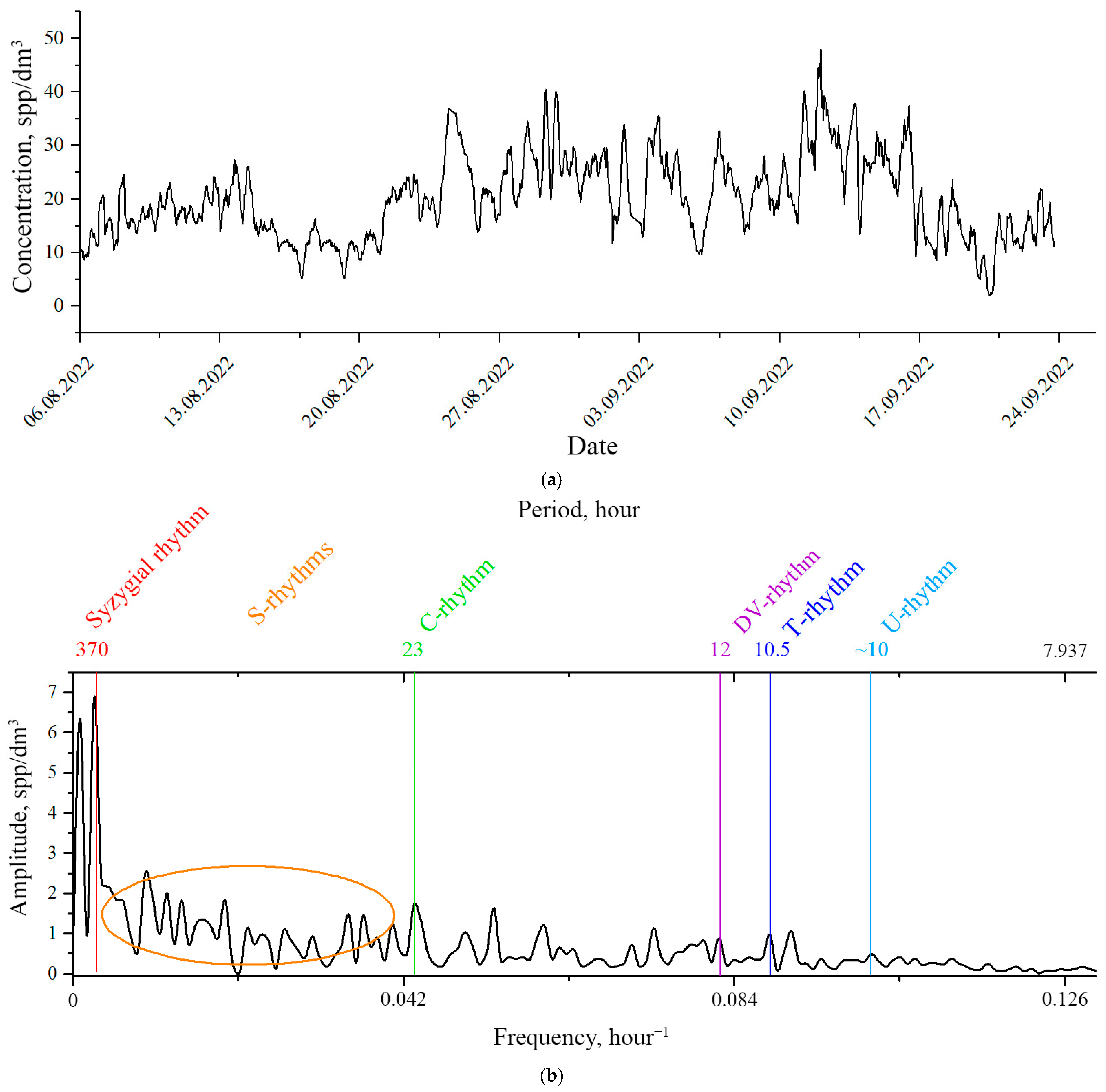
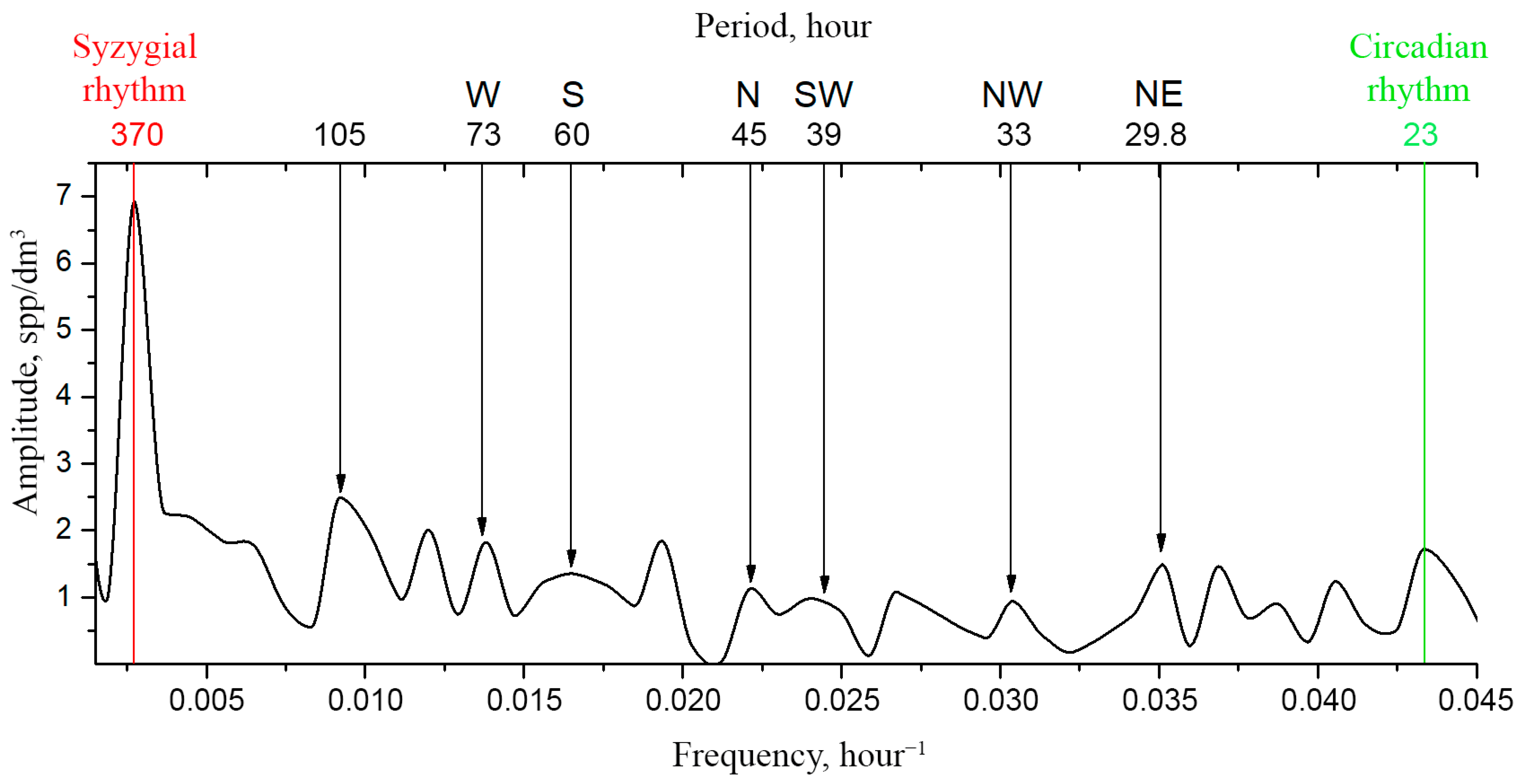


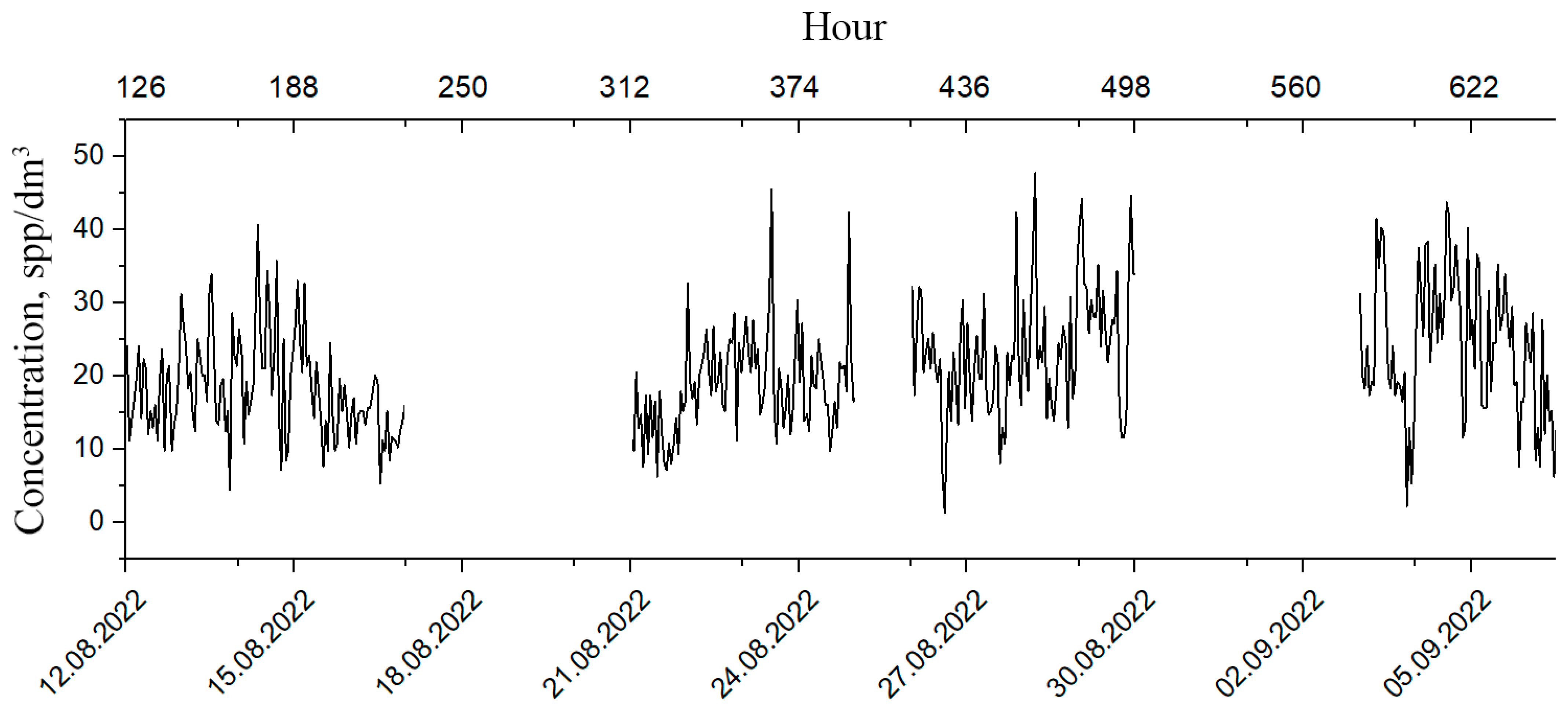
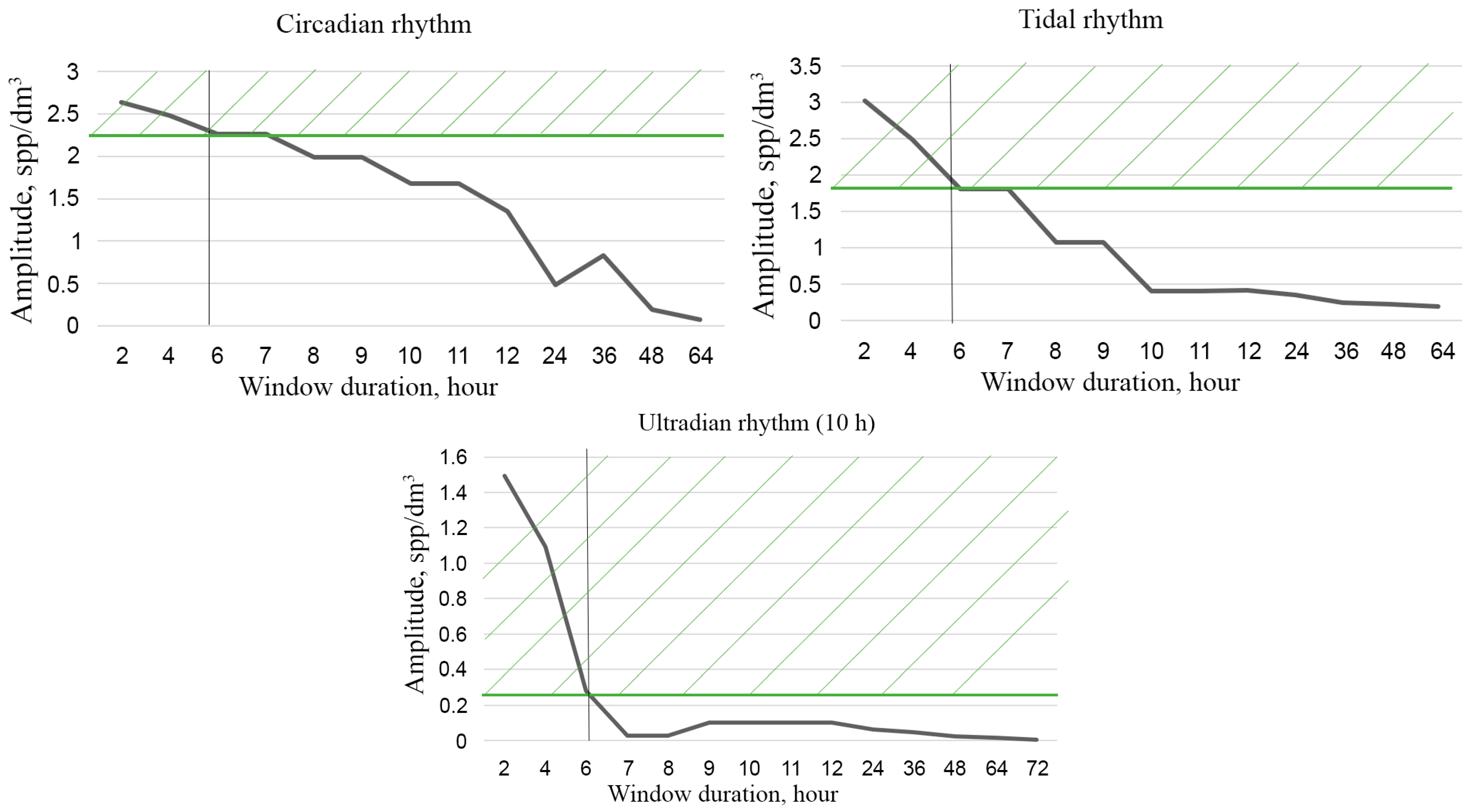
| Wind Direction | Average Duration of Wind in This Direction, Days | Corresponding Time Scale (Mode) According to Fourier Spectrum (Figure 4), Hours (Days) |
|---|---|---|
| Northeast, NE | 1.2 | 29.8 (1.24) |
| Northwest, NW | 1.4 | 33 (1.4) |
| Southwest, SW | 1.6 | 39 (1.625) |
| North, N | 1.8 | 45 (1.875) |
| South, S | 2.3 | 60 (2.5) |
| West, W | 3 | 73 (3.041) |
| Date | Sampling Segment Taken for Analysis | Fourier Representation of a Segment |
|---|---|---|
| 12 August–15 August |  |  |
| 26 August–29 August |  |  |
| 3 September–6 September |  | 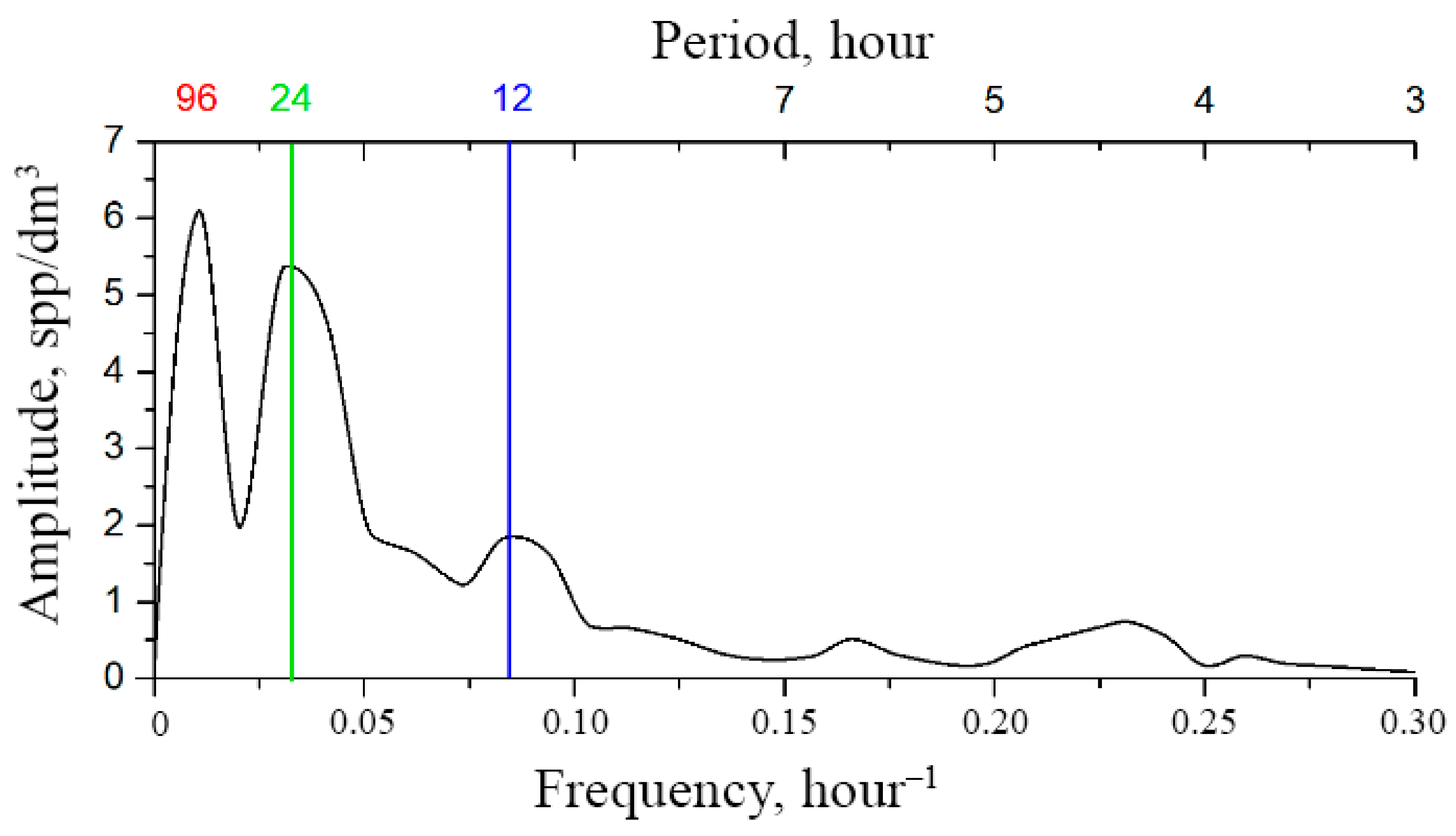 |
Disclaimer/Publisher’s Note: The statements, opinions and data contained in all publications are solely those of the individual author(s) and contributor(s) and not of MDPI and/or the editor(s). MDPI and/or the editor(s) disclaim responsibility for any injury to people or property resulting from any ideas, methods, instructions or products referred to in the content. |
© 2025 by the authors. Licensee MDPI, Basel, Switzerland. This article is an open access article distributed under the terms and conditions of the Creative Commons Attribution (CC BY) license (https://creativecommons.org/licenses/by/4.0/).
Share and Cite
Dyomin, V.; Polovtsev, I.; Kurkova, D.; Davydova, A. Modalities and Trends of Variability of Plankton Concentrations Recorded During a Digital Holographic Experiment In Situ. Water 2025, 17, 3365. https://doi.org/10.3390/w17233365
Dyomin V, Polovtsev I, Kurkova D, Davydova A. Modalities and Trends of Variability of Plankton Concentrations Recorded During a Digital Holographic Experiment In Situ. Water. 2025; 17(23):3365. https://doi.org/10.3390/w17233365
Chicago/Turabian StyleDyomin, Victor, Igor Polovtsev, Daria Kurkova, and Alexandra Davydova. 2025. "Modalities and Trends of Variability of Plankton Concentrations Recorded During a Digital Holographic Experiment In Situ" Water 17, no. 23: 3365. https://doi.org/10.3390/w17233365
APA StyleDyomin, V., Polovtsev, I., Kurkova, D., & Davydova, A. (2025). Modalities and Trends of Variability of Plankton Concentrations Recorded During a Digital Holographic Experiment In Situ. Water, 17(23), 3365. https://doi.org/10.3390/w17233365







